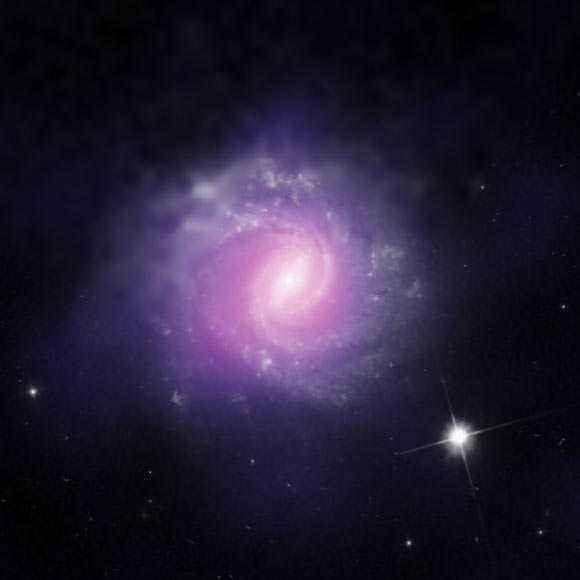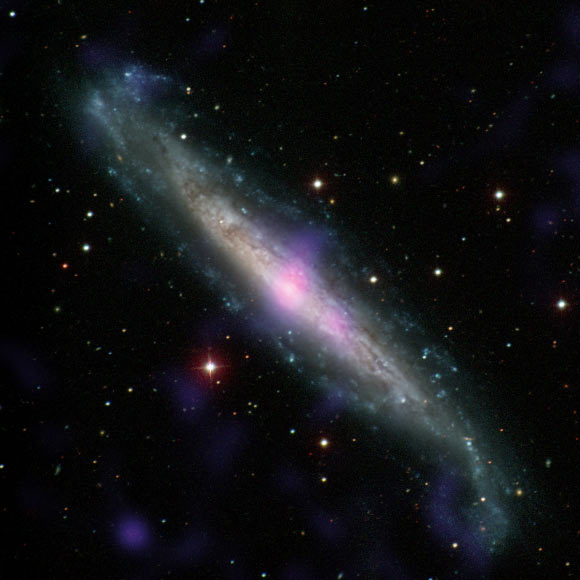NASA’s Nuclear Spectroscopic Telescope Array (NuSTAR) mission has identified two gas-enshrouded supermassive black holes, located at the centers of nearby galaxies IC 3639 and NGC 1448.

This composite image shows IC 3639, a galaxy with an active galactic nucleus. Image credit: ESO / NASA / JPL-Caltech / STScI.
Both of these black holes are the central engines of what scientists call ‘active galactic nuclei,’ according to NuSTAR project scientist Daniel Stern of NASA’s Jet Propulsion Laboratory and co-authors.
Depending on how these galactic nuclei are oriented and what sort of material surrounds them, they appear very different when examined with telescopes.
Active galactic nuclei are so bright because particles in the regions around the black hole get very hot and emit radiation across the full electromagnetic spectrum — from low-energy radio waves to high-energy X-rays.
However, most active nuclei are believed to be surrounded by a doughnut-shaped region of thick gas and dust that obscures the central regions from certain lines of sight.
“We present NuSTAR observations of two nearby active galactic nuclei, IC 3639 and NGC 1448, located at distances of 176 million light years and 39 million light years, respectively,” Dr. Stern and colleagues said.
“NuSTAR high-energy X-ray observations, combined with archival lower energy X-ray observations from NASA’s Chandra X-Ray Observatory and the Japan-led Suzaku satellite, reveal both sources to contain heavily obscured, accreting super-massive black holes.”
“These black holes are relatively close to the Milky Way, but they have remained hidden from us until now,” added co-author Ady Annuar, a graduate student at Durham University, UK.
Both of the galaxies appear to be oriented such that astronomers view them edge-on. That means that instead of seeing the bright central regions, our telescopes primarily see the reflected X-rays from the doughnut-shaped obscuring material.
“Just as we can’t see the Sun on a cloudy day, we can’t directly see how bright these active galactic nuclei really are because of all of the gas and dust surrounding the central engine,” said co-author Peter Boorman, a graduate student at the University of Southampton, UK.
The team analyzed NuSTAR data from the galaxy IC 3639 and compared them with previous observations from Chandra and Suzaku. The findings confirm the nature of IC 3639 as an active galactic nucleus.
NuSTAR also provided the first precise measurement of how much material is obscuring the central engine of IC 3639, allowing researchers to determine how luminous this hidden monster really is.
More surprising is the spiral galaxy NGC 1448, one of the nearest luminous galaxies to the Milky Way.

NGC 1448, a galaxy with an active galactic nucleus, is seen in this image combining data from the Carnegie-Irvine Galaxy Survey in the optical range and NuSTAR in the X-ray range. Image credit: Carnegie-Irvine Galaxy Survey / NASA / JPL-Caltech.
The authors discovered that NGC 1448 has a thick column of gas hiding the central black hole, which could be part of a doughnut-shaped region.
X-ray emission from NGC 1448, as seen by NuSTAR and Chandra, suggests for the first time that, as with IC 3639, there must be a thick layer of gas and dust hiding the active black hole in this galaxy from our line of sight.
The team also found that NGC 1448 has a large population of very young — just 5 million year old — stars, suggesting that the galaxy produces new stars at the same time that its black hole feeds on gas and dust.
“Through detailed studies such as we present, NuSTAR is showing that there are still plenty of interesting discoveries awaiting to be made, even in the nearby Universe,” the astronomers said.
They reported their findings Jan. 7, 2017 at the 229th Meeting of the American Astronomical Society in Grapevine, Texas.
_____
Daniel Stern et al. 2017. NGC1448 and IC 3639: Two Concealed Black Holes Lurking in our Cosmic Backyard Unveiled by NuSTAR. 229th AAS Meeting, abstract # 429.08







